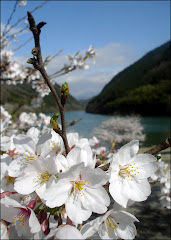
The fall colors of Sanzen-In, Kyoto. When the sun rays hit the red leaves and make them glitter warmly, it is called teriha (照葉 [てりは]).
As autumn deepens, the green leaves of deciduous trees begin to set the countryside on fire in shades of red, orange and yellow. This blaze of glory before winter sets in is admired around the world, but only in Japan has "Autumn Leaf Viewing" been ingrained as a popular cultural passtime.
The bright autumnal tints of Kyoto's foliage captivated the hearts of ancient Japanese people, who used them as motifs in literature and art for centuries. Autumn leaf viewing is thought to have become an organized event sometime during the Heian period, when the nobility would gather to listen to music, compose poems, or quietly delight in natures offering. Enjoying the fall colors is as important a traditional past time as viewing the cherry blossoms in the spring, but unlike cherry blossom viewing, which tends to be a rowdy affair, autumn viewing is a time of solitude and reflection.
The maple trees most common to Japan are called Takao maple, or Iroha maple. Takao, the place after which the tree is named, is one of the three famous spots in the foothills of Kyoto's northwestern mountains (together with Makino-o and Togano-o).
Because maples flaunt an especially gorgeous array of colors, one tends to immediately think of the maple as the definitive image of momiji. Its impossible to ignore the beautiful arrdisplay of autumn leaves on other trees, like persimmon trees (柿紅葉 [かきもみじ]), cherry blossom trees (桜紅葉 [さくらもみじ]), lacquer trees (漆紅葉 [うるしもみじ]), and rhododendrons (満天星紅葉 [どうだんもみじ]). Seeing the mixed palette of forest foilage (雑木黄葉 [ぞうきもみじ]) covering the mountains is like studying an impressionist landscape painting.
The trees with the most dramatically vivid autumn colors are found in the mountainous and northern regions of Japan, where there is a severe discrepancy in temperature between day and night. Generally, the leaves start to turn color when the temperature dips under 8 degrees Celcius (approximately 46 degrees Fahrenheit). They reach a climax when the day's lowest temperature hits 5-6 degrees Celcius (approximately 41-43 degrees Fahrenheit).Its all very scientific, and the Japanese keep careful track of these temperature changes in order to forecast where the leaves are changing, and when they will be most beautiful. Every news program devotes a special segment, along with it weather forecast, to an autumn leaves update.
Some trees with leaves that turn yellow rather than red-- such as a type of oak (檪 [くぬぎ] kunugi) or gingko trees (銀杏 [いちょう])-- are also called momiji, although when written with Chinese characters, the form is slightly different. The Chinese character for "yellow" (黄) replaces that of the character for "red" (紅). In that case, momiji is written as "黄葉" (yellow leaves), instead of "紅葉"(red leaves).
As a linguist, I have always believed that the amount of words dealing with a subject, as well as the specific meaning contained in a single utterance help shed light on the cultural importance of the subject. The Japanese language has no shortage of words to describe the leaves of fall. For example, the term kusa momiji (草紅葉 [くさもみじ]) describes the way autumn leaves fall and spread themselves over grass. I wonder if they have a word for a pile of leaves gathered together for the expressed purpose of jumping into them--although I doubt it because, sadly, I've never seen anyone jumping into a pile of freshly raked or hand gathered leaves in Japan! Alas...
Other related terms:
初紅葉 [はつもみじ] hatsumomiji, first momiji
薄紅葉 [うすもみじ], usumomiji, pale momiji
紅葉 【もみじ】 momiji, (もみぢ), red leaves / red (maple) leaves
夕紅葉 【ゆうもみじ】 yūmomiji, evening red leaves
むら紅葉 【むらもみじ】 muramomiji, village's red leaves
谿紅葉 【たにもみじ】 tanimomiji, valley's red leaves
紅葉山 【もみじやま】 momijiyama, red-leaved mountain
 Paper umbrellas popped on the Japanese scene during the Edo period. Featured in many of the woodblock prints of Hiroshige Ando`s '100 scence of everyday life' these wax coated paper umbrella spared the people from the heat of the harsh, summer sun and sheltered them from rain. Utamaro Kitagawa also depicted these traditional umbrellas in his Ukiyoe (woodblock) masterpieces of beautiful women. These days, Japanese umbrellas play an important role in tea ceremony, dance, and Kabuki as an essential representation of Japanese traditional culture.
Paper umbrellas popped on the Japanese scene during the Edo period. Featured in many of the woodblock prints of Hiroshige Ando`s '100 scence of everyday life' these wax coated paper umbrella spared the people from the heat of the harsh, summer sun and sheltered them from rain. Utamaro Kitagawa also depicted these traditional umbrellas in his Ukiyoe (woodblock) masterpieces of beautiful women. These days, Japanese umbrellas play an important role in tea ceremony, dance, and Kabuki as an essential representation of Japanese traditional culture.
 Two nisemono maiko, or imposters (toursits playing dress-up), send pictures of their transformation to friends via keatai, or mobile phone.
Two nisemono maiko, or imposters (toursits playing dress-up), send pictures of their transformation to friends via keatai, or mobile phone.

 The tangerine tunnel of torii leading through the green trees and autumn leaves of Fushimi Inari.
The tangerine tunnel of torii leading through the green trees and autumn leaves of Fushimi Inari.








